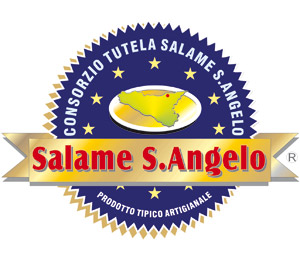History, tradition and territory
Salame Sant’Angelo takes its name from the production village Sant’Angelo di Brolo, in Nebrodi, in the province of Messina. The tradition of the processing of pork meat dates back to the end of the 11st century. In that time the Normans freed themselves from Arab domination and from food impositions (the Muslim religion forbids to eat pork meat). When pork meat was introduced into daily food, Sant’Angelo became a unique tradition custodian in Sicily.
Production
Il Salame Sant’Angelo PGI it is obtained from selected pork meats. The paste is obtained from the mixture of selected cuts: thigh, loin, fillet, shoulder, coppa, and bacon. Then grain black pepper and sea salt is introduced into a natural casing, and then there is the maturation stage.
This phase has a variable period in proportion to the size of the product and takes place in large rooms where the salami takes the scent of the surrounding vegetation. The microclimate of the production area plays a fundamental role in the maturation phase. The air currents, temperature, and humidity define the characteristic fragrant and slightly spicy aroma of this product. At the end of the process, the weight of product can be from 200 g to 3.5 kg.
Tasting
The salami has a ruby red color with visible and well-defined grains of fat. It is recommended to cut it into thick slices, as tradition dictates. The salami has a ruby red color with visible grains of fat. It’s recommended to cut it into thick slices, as tradition. Excellent with vegetables in oil, olives, and bread. It’s matched with structured red wine.
Interesting facts
In 1855 there was a regulation for the production and marketing of salami. In addition to this, every holder of this product had to present a declaration called “rivelo”: a sort of self-certification to declare the quantity of product possessed.
Mark
Protected Geographical Indication (PGI) recognized under Reg.ne EU Reg.to CE n.994 of 25.09.2008 GUCE n. 258 of 26.09.2008.



